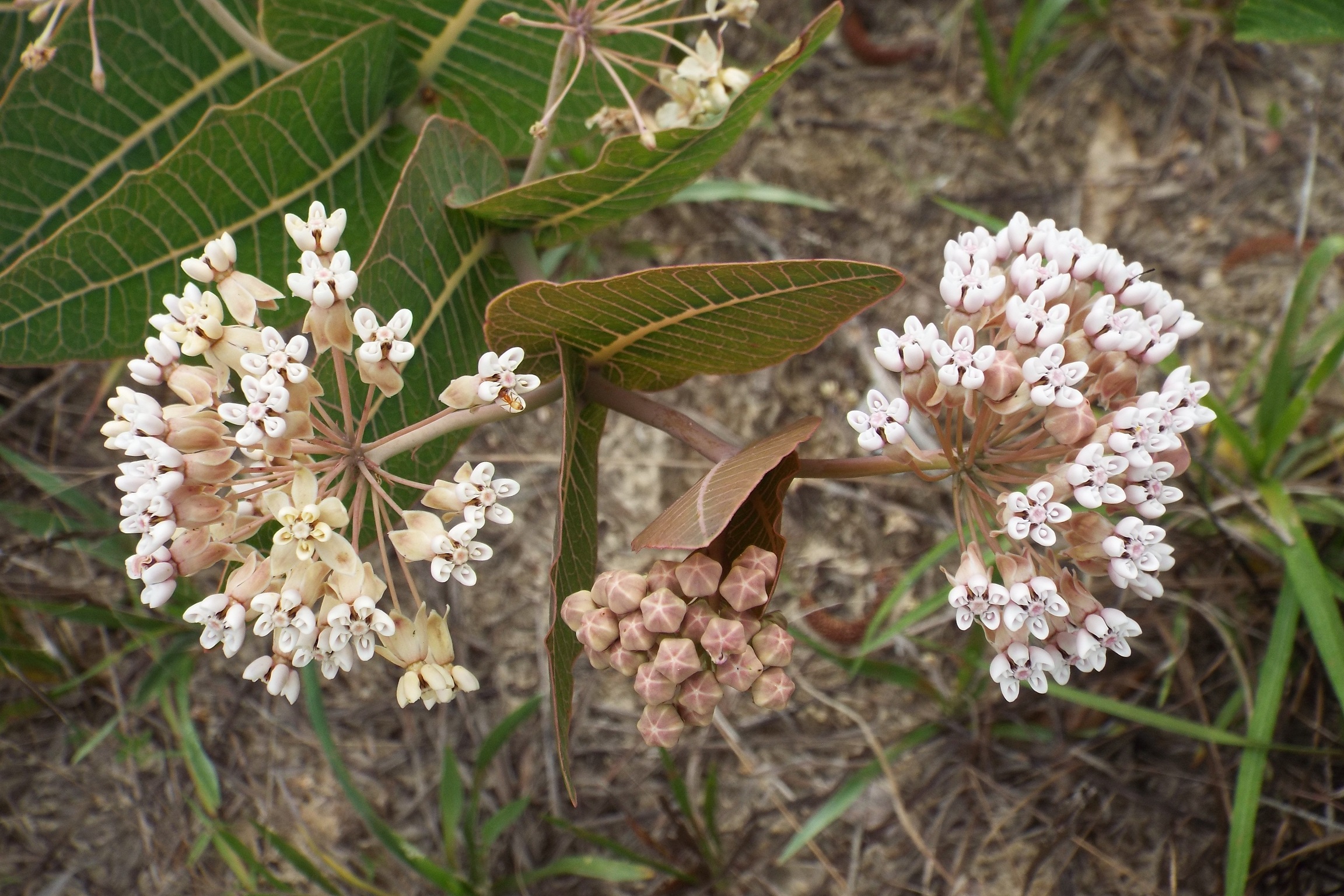Difference between revisions of "Asclepias humistrata"
(→Description) |
(→Photo Gallery) |
||
| Line 46: | Line 46: | ||
<gallery widths=180px> | <gallery widths=180px> | ||
</gallery> | </gallery> | ||
| + | |||
==References and notes== | ==References and notes== | ||
Florida State University Robert K. Godfrey Herbarium database. URL: [http://herbarium.bio.fsu.edu http://herbarium.bio.fsu.edu]. Last accessed: November 2015. Collectors: Loran C. Anderson, M. Boothe, Edwin L. Bridges, Richard Carter, Jack P. Davis, Elmer, J.P. Gillespie, Robert K. Godfrey, R.D. Houk, Lisa Keppner, Gary R. Knight, Robert Kral , H. Larry, Robert L. Lazor, Karen MacClendon, Sidney McDaniel, R.A. Norris, Steve L. Orzell, C. Prichard, Grady W. Reinert, Annie Schmidt, E. Stipling, D.B. Ward, S.J. Ward, Rodie White, Mary Margaret Williams, Jean W. Wooten. States and Counties: Florida: Baker, Bay, Calhoun, Clay, Dixie, Escambia, Franklin, Gadsden, Gilchrist, Hamilton, Jackson, Leon, Levy, Liberty, Marion, Nassau, Okaloosa, Pasco, Polk, Santa Rosa, Taylor, Volusia, Wakulla, Washington. Georgia: Grady. Compiled by Tall Timbers Research Station and Land Conservancy. | Florida State University Robert K. Godfrey Herbarium database. URL: [http://herbarium.bio.fsu.edu http://herbarium.bio.fsu.edu]. Last accessed: November 2015. Collectors: Loran C. Anderson, M. Boothe, Edwin L. Bridges, Richard Carter, Jack P. Davis, Elmer, J.P. Gillespie, Robert K. Godfrey, R.D. Houk, Lisa Keppner, Gary R. Knight, Robert Kral , H. Larry, Robert L. Lazor, Karen MacClendon, Sidney McDaniel, R.A. Norris, Steve L. Orzell, C. Prichard, Grady W. Reinert, Annie Schmidt, E. Stipling, D.B. Ward, S.J. Ward, Rodie White, Mary Margaret Williams, Jean W. Wooten. States and Counties: Florida: Baker, Bay, Calhoun, Clay, Dixie, Escambia, Franklin, Gadsden, Gilchrist, Hamilton, Jackson, Leon, Levy, Liberty, Marion, Nassau, Okaloosa, Pasco, Polk, Santa Rosa, Taylor, Volusia, Wakulla, Washington. Georgia: Grady. Compiled by Tall Timbers Research Station and Land Conservancy. | ||
Radford, Albert E., Harry E. Ahles, and C. Ritchie Bell. Manual of the Vascular Flora of the Carolinas. 1964, 1968. The University of North Carolina Press. 848-852. Print. | Radford, Albert E., Harry E. Ahles, and C. Ritchie Bell. Manual of the Vascular Flora of the Carolinas. 1964, 1968. The University of North Carolina Press. 848-852. Print. | ||
Revision as of 18:58, 16 February 2016
Common name: Pinewoods Milkweed; Sandhill Milkweed
| Asclepias humistrata | |
|---|---|

| |
| Asclepias humistrata | |
| Scientific classification | |
| Kingdom: | Plantae |
| Division: | Magnoliophyta - Flowering plants |
| Class: | Dicots |
| Order: | Gentianales |
| Family: | Apocynaceae |
| Genus: | Asclepias |
| Species: | A. humistrata |
| Binomial name | |
| Asclepias humistrata Walter | |

| |
| Natural range of Asclepias humistrata from USDA NRCS [1]. | |
Contents
Taxonomic notes
Description
In general, with the Asclepias genus, they are perennial herbs usually milky sap. The stems are erect, spreading or decumbent and usually are simple and often solitary. The leaves are opposite to subopposite, are sometimes whorled, and rarely alternate. The corolla lobes are reflexed and are rarely erect or spreading. The filaments are elaborate into five hood forming a corona around the gynosteguim. The corona horns are present in most species. (Radford 1964).
More specifically, for A. humistrata, the stems are glabrous, simple, stout, and rarely solitary; they spread ascendingly, and grow 2-7 dm tall. The leaves are opposite, about 5-8 pairs, ovate in shape, and 6-10 cm long, 4.5-8.5 cm wide. The leaves are widely acute to obtuse, the margins are flat, auriculate, more or less amplexicaul, subsucculent, glaucous, the veins are pink to lavender in color, and are sessile. There are 2-5 or more umbels beginning from the upper 2-5 nodes, and are 3-5 cm broad. The corolla is pale rose or lavender in color, the lobes are reflexed, and are 5-6.5 mm long. The corona is 3-5 mm in diameter. The horns are shorter than the hood. The follicles are erect and are 9-14 cm long, 1.3-1.8 cm broad. Flowers May to June; June to July. (Radford 1964).
Distribution
Ecology
Habitat
In the Coastal Plain in Florida and Georgia, A. humistrata can occur in scrub oak sand ridges, longleaf pine-scrub oak ridges, pine-palmetto thickets, turkey oak scrubs, low sand dunes, and mixed pine hardwood associations. It can occur in disturbed areas such as sandy fallow fields and roadsides (FSU Herbarium). Associated species include Coreopsis basalis, Hymenopappus scabiosaeus, Liatris, Panicum, Leptoloma cognatum, Q. laevis, Q. incana, Q. geminata, Aristida stricta, Vaccinium stamineum, V. myrsinites and Licania michauxii (FSU Herbarium). Soil types include loamy sand and coarse sand (FSU Herbarium).
Phenology
Flowers March through October and fruits April through October (FSU Herbarium).
Seed dispersal
Seed bank and germination
Fire ecology
It has been observed growing in burned over, longleaf pine forests (FSU Herbarium).
Pollination
Use by animals
Diseases and parasites
Conservation and Management
Cultivation and restoration
Photo Gallery
References and notes
Florida State University Robert K. Godfrey Herbarium database. URL: http://herbarium.bio.fsu.edu. Last accessed: November 2015. Collectors: Loran C. Anderson, M. Boothe, Edwin L. Bridges, Richard Carter, Jack P. Davis, Elmer, J.P. Gillespie, Robert K. Godfrey, R.D. Houk, Lisa Keppner, Gary R. Knight, Robert Kral , H. Larry, Robert L. Lazor, Karen MacClendon, Sidney McDaniel, R.A. Norris, Steve L. Orzell, C. Prichard, Grady W. Reinert, Annie Schmidt, E. Stipling, D.B. Ward, S.J. Ward, Rodie White, Mary Margaret Williams, Jean W. Wooten. States and Counties: Florida: Baker, Bay, Calhoun, Clay, Dixie, Escambia, Franklin, Gadsden, Gilchrist, Hamilton, Jackson, Leon, Levy, Liberty, Marion, Nassau, Okaloosa, Pasco, Polk, Santa Rosa, Taylor, Volusia, Wakulla, Washington. Georgia: Grady. Compiled by Tall Timbers Research Station and Land Conservancy.
Radford, Albert E., Harry E. Ahles, and C. Ritchie Bell. Manual of the Vascular Flora of the Carolinas. 1964, 1968. The University of North Carolina Press. 848-852. Print.